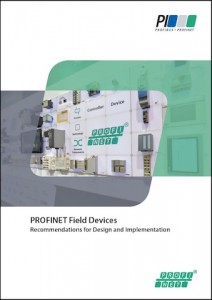High quality despite variety
When a user decides on PROFINET, he has a choice of thousands of different products developed and available worldwide today, such as I/O devices, actuators, sensors, network and infrastructure components, and controllers. This variety gives the user maximum freedom to design his own plant and automation systems. The device manufacturer has access to a wide range of different hardware- and software-based basic technologies for optimal implementation of the PROFINET interface based on his requirements. The flexibility now enjoyed by the user is also due to the fact that he can rely on PROFINET and PROFIBUS products from different manufacturers to function smoothly in terms of interface conformance and, in particular, in interaction with each other. This is ensured, in turn, by a refined certification and qualification system that has been in place at PROFIBUS & PROFINET International (PI) for approximately 25 years.
New challenges posed by Ethernet
The Ethernet-based OT communication (Operational Technology) with PROFINET opens up new markets for many device manufacturers and enables direct connection to IT communication (Information Technology) due to PROFINET’s openness for TCP/IP. This is reinforced by the global trend surrounding Industrie 4.0 and the Industrial IoT. As a consequence, the data traffic in these applications is increasing significantly. This can cause considerable stress on devices in the field. Each access to production data, but also to diagnostic information of the network or an individual field device, must nevertheless occur without affecting any other access.
PROFINET has always been a very robust, high-performance technology that meets the real-time requirements of industrial automation even with high data volumes. PROFINET has prevailed in the market due to its openness and functionality. Besides its scalable communication, other functions include the powerful diagnostics model and the ability to co-exist with Internet protocols on the same cable. Moreover, functions such as Shared Device and the redundancy concept have been added to the portfolio.
For integration of the various PROFINET functions, device manufacturers now have access to a large selection of possible suppliers of basic technology, from standard Ethernet controllers, specific communication controllers, plug-in modules, and FPGAs to special PROFINET ASICs. Device certification guarantees the problem-free interaction of these many different device implementations in machinery and equipment.
Components of PROFINET device development
To support device manufacturers in the efficient integration of PROFINET interfaces in  products, PI has drafted the guideline PROFINET Field Devices: Recommendations for Design and Implementation that recommends a series of steps and includes information about the individual steps. Whether a new PROFINET device is being developed or a PROFINET interface is being added to an existing device, the guideline provides guidance to development personnel for these tasks. The extensive information and recommendations in the guideline are formulated as best practices for the reader who already knows PROFINET or is totally new to the subject.
products, PI has drafted the guideline PROFINET Field Devices: Recommendations for Design and Implementation that recommends a series of steps and includes information about the individual steps. Whether a new PROFINET device is being developed or a PROFINET interface is being added to an existing device, the guideline provides guidance to development personnel for these tasks. The extensive information and recommendations in the guideline are formulated as best practices for the reader who already knows PROFINET or is totally new to the subject.
All disciplines involved must collaborate to develop intelligent products that meet industrial requirements. These include mechanics, hardware, software, project management, product management, and last but not least, marketing. This guideline addresses all these topics that are relevant in the context of development of a PROFINET interface. It also references sources with detailed information on relevant subjects. It thus applies to everyone involved in development – no matter whether they work in different departments or whether all functions are executed in a dual role. Fast, successful development is only possible when all aspects are taken into consideration.

The development process starts with the analysis of customer requirements for a PROFINET field device or interface, which may differ depending on the field of application and industry sector and must therefore be defined with certainty in advance. The PROFINET Profiles, Conformance Classes, and Application Classes support this analysis. This step is critical both for market acceptance and for cost effectiveness.
In the run-up to the actual development, decisions must also be made about the hardware and software implementation. These are determined by the necessary functionality/performance (e.g., device model, diagnostics, I&M, asset management, RT/IRT, time synchronization/sequence of events, integration of fieldbuses such as PROFIBUS) and influence the selection of the suitable basic technology (e.g., software stack on microcontroller, ASIC, FPGA, communication module, etc.). For support of the decision-making process regarding available implementation options, the guideline references the PI brochure “PROFINET Technology – The easy way to PROFINET.”
In the next development step, the data-related description of the PROFINET field device must be generated via a GSD file. It plays a key role in the engineering phase, is very important for ease of use of the engineering tool, and is essential for efficient certification. Every PROFINET field device must be certified in order to prevent incompatibilities. The guideline presents the individual process steps. Finally, information concerning the life cycle of a device is provided. This includes issues such as added functionality, hardware and software changes, compatibility, etc.
Looking at the future, it must be noted that we are currently at the start of a new era. In regard to Industrie 4.0 in particular, we can expect additional concepts and developments, new devices, functions, and combination as well as new ideas that are not yet conceivable today. Nevertheless, users can be certain that the same rules for reliability will apply to future devices as applied to the very first PROFIBUS product.
Quality monitoring of PROFINET implementations
An essential building block for the success of PROFIBUS and PROFINET technologies is the high quality of products. Users around the world can rely on the fact that devices and components will not only function but will meet expectations, in particular, for the interaction in automation systems. This means: all PROFIBUS and PROFINET devices are not only developed according to defined specifications but are also tested for practical suitability in precisely described test scenarios. The tests are standardized, reproducible, and easy to apply. And they apply to all PROFIBUS and PROFINET communication standards, the related integration technologies, such as GSD or FDI, profiles for device families (e.g., process-related field devices PROFIBUS PA and Remote IO), special applications (e.g., PROFIsafe and PROFIenergy), and accompanying measures such as security specifications.
This is also the basis for many product development processes of the manufacturers of devices, communication and control system components, as well as associated engineering tools. To ensure that quality standards are met, compliance with the specifications must be checked in the products.
To fulfill all these tasks, PI has a framework for development and maintenance of specifications, preparation and implementation of testing, and organization of certificate granting. It includes the complete quality management process from requirements and specifications to recertification of products.
PI Test Labs are responsible for certification of products with PROFIBUS and PROFINET interfaces. In this way, the standard conformity and interoperability with other products of various manufacturers can be guaranteed. Their problem-free use in a common plant is thus possible. Certification is mandatory for PROFINET products.
PI is currently working on a powerful new PROFINET test tool for use during development in the accredited PI Test Labs for certification of PROFINET interfaces.
An example of this is a newly provided function that has already been incorporated in the test procedures and that stems from experience gained with large PROFINET networks. In plants with many nodes, an unforeseen elevated network load can occur during commissioning, as well as during operation. The available nodes must be able to process this unusual load. Otherwise, it leads to reduced plant availability due to failure or malfunction of devices. It is difficult for operators to predict such scenarios since the probability of a high data volume is dependent on the system. The reason is that the data traffic is determined by cyclic and acyclic data exchange as well as the event-driven data volume. With the help of the Security Tester Level 1, such a Denial of Service can already be simulated in advance. The field devices are tested under stress conditions to simulate an unpredictable load and, thus, to minimize device failures. The test relating to the network load is an example of how requirements of end users – here the automotive industry – flow into the test procedures.
With the growing application areas of PROFINET technology, it is only logical that other function tests will also be added in the future. Users will also benefit here from a well thought out approach: each new version of the test tool will be separately released for use by a defined committee. Upgrades of the test system are being planned for Hannover Fair and for SPC IPC Drives. In this way, PI provides device manufacturers a reliable planning transparency. Of course, device manufacturers do not have to change abruptly to the latest version. The previous version will remain valid another year in each case.
Plugfests provide another opportunity for monitoring development quality. PI has been holding these events in Germany for years and is in the process of establishing them in other countries and regions where manufacturers develop products. The first of these took place in the USA in August 2016. For one thing, representatives of different industries participate in the Plugfests. For another thing, different product types (controllers, I/O devices, drives, valve blocks, sensors, etc.) are combined into one system. The goal is to test real-world interaction with a wide range of products of different manufacturers under controlled conditions. Important in this regard is that periodic prototypical implementations of products with integrated basic technologies of different suppliers are brought to bear before these products come together at the end user. This brings a high level of interoperability to plants from the outset. This experience benefits not only manufacturers in the development of their products but also the certification tests and test procedures.
Safety for product developers
Certification does not release the manufacturer from responsibility for its device. Accordingly, these tests by PI cannot check the accuracy of a field device, the agreement between setpoint and actual value, or the quality of a product. Equally, safety-relevant tests must be accepted by the corresponding test organizations. But the test by an independent test lab provides additional assurance of the development of field devices and other components. Developers have had very positive experiences with this, while proceeding strictly according to the PROFINET specification for the development. Generally, the official certification then no longer poses a problem. Rather, users can count on solid implementation of PROFINET and subsequent problem-free operation.
 Author: Dr. Peter Wenzel, Managing Director of PI Germany (PROFIBUS Nutzerorganisation e.V.)
Author: Dr. Peter Wenzel, Managing Director of PI Germany (PROFIBUS Nutzerorganisation e.V.)
